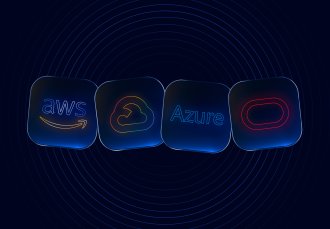
Contact us
Our team would love to hear from you.
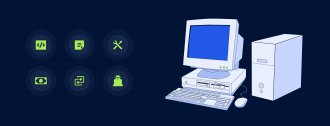
In this guide to software modernization, we delve into the process of updating legacy systems, detail why it is critical for businesses, outline approaches and trends, and address the challenges companies may encounter along the way.
Before getting into the details of the system modernization process, let’s define legacy software itself. A legacy application or system is an information system that is crucial for a company’s day-to-day operations but based on outdated or ineffective technologies.
Outdated software is a barrier to achieving evolving business goals and adapting to changing market demands. To remain current with business and industry requirements, it is critical for companies to modernize their legacy systems. This involves updating or upgrading the software using advanced technologies.
Before embracing system modernization, it’s important to understand why legacy software can be damaging to a company and what benefits legacy software modernization brings.
Maintaining the status quo with legacy applications may seem like a straightforward decision, but it’s important not to underestimate the negative impact legacy systems can have on businesses. One of the primary challenges companies face is security vulnerabilities, which can result in data breaches, theft, legal issues, and reputational damage. Legacy systems also have limitations in flexibility, functionality, and connectivity—they are difficult to adapt and scale according to company needs and challenging to integrate with other systems. Finally, legacy applications are expensive to maintain due to the need for experienced professionals with specialized skills to support the system.
The graph below shows the top reasons driving companies’ legacy system modernization efforts in 2023.
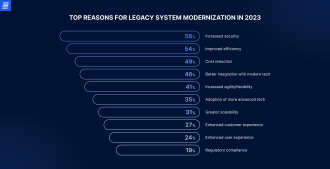

Source: statista.com
Legacy system modernization can bring businesses significant benefits, including the following:
Information is a crucial asset for companies, making data protection a primary concern. Legacy software is prone to cyberattacks, so system modernization is necessary to keep a company’s data secure. Modernized solutions adhere to the latest security regulations, effectively addressing issues, such as data breaches and cyberattacks.
Legacy software slows down business processes due to its inability to adapt to changing conditions. Modernizing legacy systems allows seamless scalability and flexibility, empowering companies to grow and enhance performance as workloads expand.
Legacy app modernization enables businesses to streamline their processes and boost operational efficiency through improved functionality, additional features, automation, and optimization. Modern solutions eliminate many barriers that hinder efficient workflows, including system interruptions, performance lags, and diagnostic issues.
Business and market requirements change constantly, and legacy systems struggle to keep up with evolving trends and demands. System modernization helps address issues such as outdated interfaces, lagging performance, and poor user experience, which can reduce engagement and productivity. Through the modernization process, companies can incorporate new technologies, add valuable features and functions, and improve adaptability. This allows them to outperform competitors, enhance the responsiveness and intuitiveness of the application, improve user-oriented functionality, and increase user satisfaction.
Before beginning the modernization journey, businesses must assess their system needs and requirements. Based on these factors, along with the software’s condition, resources, and desired outcome, there are various approaches or strategies to consider. The following are seven key legacy system modernization strategies.
Encapsulation involves taking key legacy components and making them accessible as a service via an API. This approach to system modernization allows companies to update the application interface with existing or extended features with minimal risk and resources. While encapsulation quickly enhances the user experience, it fails to address maintenance issues.
Rehosting means migrating the application or its components to another (physical, cloud, or virtual) environment without changing it. This is another fast and low-risk system modernization approach that enhances performance while leaving the business logic intact. Rehosting does not affect workflow while enhancing performance and security.
Replatforming involves moving the existing application to a new platform or infrastructure, retaining the core structure and making minimal changes to the code—only what is required to enable the system to function properly on the new platform. This modernization approach enhances an application’s scalability, leveraging the benefits of the new platform.
With refactoring, only the code is modified while the external behavior and core functionality remain intact. The primary goal is to eliminate features, frameworks, and code components that are no longer relevant. This improves system flexibility and code maintainability and helps avoid system failures.
Rearchitecting involves transforming the code of a legacy system to migrate it to a new architecture, thereby improving its performance and leveraging enhanced capabilities. This approach allows companies to preserve business logic while redesigning the application using modern technologies and adding custom features.
The approach entails a complete redesign of the system or its components, bringing them in line with modern requirements. Rebuilding offers numerous benefits, including improved security, productivity, and scalability, along with customized features, automation, and optimization. However, it is a high-risk and costly approach that requires skillful execution.
This is one of the most radical legacy system modernization approaches. It entails completely removing the old application component and creating a new one from scratch. In this case, a full replacement is necessary to ensure the software complies with the set requirements and functions smoothly.
While offering numerous benefits for businesses, the process of legacy system modernization can also pose challenges that companies must consider in advance.
When companies undertake system modernization, they are often faced with technical debt—the consequences of opting for the easiest and quickest solution to a problem rather than one that is comprehensive, reliable, and sustainable. Motivated by short-term gains, businesses sacrifice resources, time, and software quality. In a survey by Gartner, 91% of respondents (40 out of 44) recognized the impact of technical debt from legacy systems on agility and speed of delivery.
To tackle technical debt, companies can use the following best practices:
The technical debt from the outdated system should be traced back to its corresponding business area to assess its business impact and estimate the associated profit and loss. This facilitates the development of a relevant strategy to address the debt.
A suitable modernization approach will make the software more maintainable, flexible, and adaptable, thus reducing technical debt.
Paying down technical debt all at once is risky and usually impossible. The strategy should prioritize consistent debt reduction by focusing on one task at a time.
Legacy system modernization primarily aims to improve security by updating and enhancing the software to comply with modern regulations. However, legacy software is vulnerable to security issues during the modernization process, including cyberattacks. Companies have several options to ensure the security of their systems:
During the modernization process, data is moved from the legacy system to a new one. This is a complex procedure that poses the risk of losing valuable information. To ensure that all necessary data is retained during the update, companies can take several precautionary measures:
The manufacturing sector, encompassing a wide range of industries from automotive to food and beverages, has long been a driving force of economic and social development.
To ensure efficient legacy modernization, key technologies are utilized. The following legacy modernization trends can help future-proof the software.
Cloud computing offers companies numerous benefits: enhanced scalability, flexibility, cost-effectiveness, and more. However, migration to the cloud (replatforming, rehosting) is a complex process that requires a thorough strategy and reliable cloud experts by your side.
DevOps focuses on the collaboration between development and operations teams. In system modernization, the DevOps approach allows companies to take advantage of fast feedback, continuous delivery, and automation, promoting agility, reliability, and speed.
Containerization is a software packaging method that makes cloud deployment and operation a simple and seamless experience. Using containers, a legacy system or its components are transformed into lightweight packages and upgraded to a modern version. This enhances the scalability, portability, and flexibility of the software, allowing companies to fully exploit cloud technology.
One of the characteristics of legacy applications is monolithic architecture, which is a bottleneck for agility, quick changes, and integration with other technologies. Switching to microservices for legacy system modernization allows for easy scalability and independent deployment, applying the most suitable solutions for each microservice.
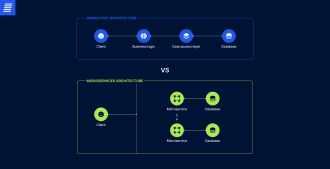

EffectiveSoft is an expert in software development, with more than 20 years of experience and a high level of proficiency in various domains and technologies. Legacy system modernization is one of our key services, as we strive to help companies stay abreast of the latest technology and industry trends. The following three case studies demonstrate how we modernize legacy systems.
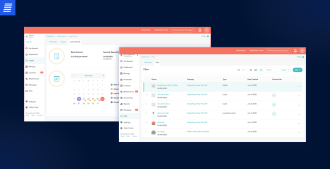

ManageCasa is a web application for property owners, landlords, and tenants that helps users complete their everyday tasks, combining all aspects of property management into one platform. EffectiveSoft developers were chosen to update the application with the latest technology and add new functionality.
Our team has been gradually refactoring the platform’s components to improve and extend them. We also added new modules, such as a website builder, messages, property management terms, reports, and more.
We continue our cooperation with ManageCasa, keep refactoring and advancing the solution and updating the Angular framework each time a new version is released. Currently, the application is expanding its functionality and incorporating more valuable features while simultaneously delivering high performance.
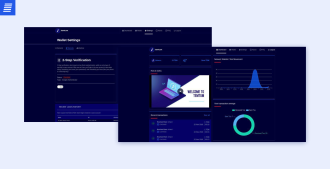

Dragon Infosec, Ltd. specializes in cutting-edge cybersecurity and cryptocurrency solutions, offering advanced protection against cyberattacks, as well as expertise in blockchain networks, AI, and cryptocurrency. The company contacted EffectiveSoft to reengineer its existing blockchain technology, increasing its speed and improving security.
Our specialists combined the Temporary Blockchain platform with Temtum API, an application for performing transactions, and Temtum Wallet, an application for transferring the Temtum cryptocurrency, to develop a new cryptocurrency.
The reengineered blockchain technology allows for improved scalability, enhanced security, and lower resource consumption due to decentralized data storage, quantum-resistant encryption algorithms, and the removal of the block size limit.
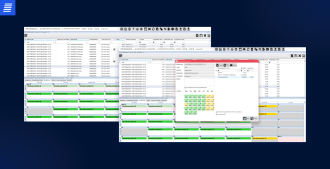

Our client has been providing their partners with solutions for financial, legal, and HR operations for over 50 years. Their under-performing web application lacked a dedicated business logic layer and required numerous manual operations with no enhancement and optimization capabilities. The client turned to EffectiveSoft to replace their software with a functional desktop application.
Our experts created a modular desktop solution with enhanced performance and functionality. To achieve this, our engineers separated the business logic layer and transferred data to the cloud database.
The new application accurately computes variable salaries, taxes, and internal financial reports while adhering to all country and company regulations. This automated, easy-to-use solution streamlines the salary and tax management processes.
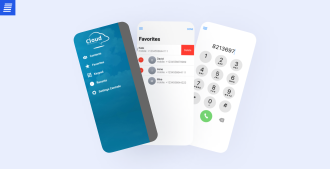

The Cloud Group, a Belgian telecom service, specializes in cloud telephony, offering a SaaS (Software as a Service) model to its local and European prospects. The company turned to EffectiveSoft to redevelop the CloudCal app, making it a cross-platform solution.
Utilizing robust cloud software, our engineers redeveloped the application within the React Native framework, seamlessly transferring the code between iOS and Android application platforms.
The updated solution facilitated a faster time to market and offered seamless scalability and flexibility. In the future, the application can be effortlessly integrated with other services, and CloudCall functionality can be easily extended.
Legacy modernization is an important step forward for companies that want to improve business performance, streamline their processes, and stay current in the digital world. However, legacy modernization is a complex endeavor that requires a holistic approach and specialized expertise. EffectiveSoft offers comprehensive legacy system modernization services to help you update your software smoothly while meeting your business objectives. Contact us to launch your project!
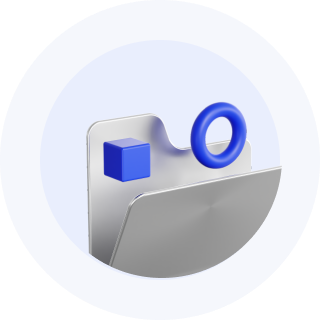
The process of legacy system modernization depends on the approach. However, it typically starts with a thorough analysis and evaluation of the legacy software. This includes identifying existing issues, assessing system’s business value and agility, evaluating its complexity, and defining modernization goals. To ensure that your plan is comprehensive and effective, find a skillful partner. Contact the experts at EffectiveSoft to begin collaboration.
There are three main steps in selecting the most effective approach for legacy system modernization:
First, analyze the current state of the system—weaknesses, issues, risks, etc. Next, define the objectives of modernization, including what you want to achieve and what characteristics and features are required. Finally, choose the approach that correlates with your demands and needs.
Some of the main benefits provided by modernization are improved performance, enhanced security, cost savings, flexibility, and competitive advantage.
Can’t find the answer you are looking for?
Contact us and we will get in touch with you shortly.
Our team would love to hear from you.
Fill out the form, and we’ve got you covered.
What happens next?
San Diego, California
4445 Eastgate Mall, Suite 200
92121, 1-800-288-9659
San Francisco, California
50 California St #1500
94111, 1-800-288-9659
Pittsburgh, Pennsylvania
One Oxford Centre, 500 Grant St Suite 2900
15219, 1-800-288-9659
Durham, North Carolina
RTP Meridian, 2530 Meridian Pkwy Suite 300
27713, 1-800-288-9659
San Jose, Costa Rica
Escazú Corporate Centre, Piso 6
40602, 1-800-288-9659